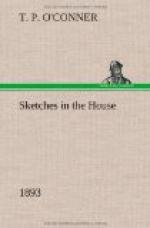[Sidenote: The lawyer and the hangman.]
In all such squalid tragedies, men of the Carson type are a necessary portion of the machinery, as necessary as the informer that betrays—as the warder who locks the door—as the hangman who coils the rope. Mark you, all the forms—all the precautions—all the outward seeming of English law and liberty—are in these Irish courts. The outside is just the same as in any court that meets in the Old Bailey; but it is all the mask and the drapery, behind which the real figures are the foregone verdict, the partisan judge—the prepared cell or constructed gallows. In the regime of coercion which has just expired, the whole machinery was in motion. The last sentence of the law was not resorted to in political offence, for the days of rebellion in the open field had passed. But there were the Resident Magistrates ready to do their master Balfour’s bidding, and to send men to imprisonment, in some cases followed by bread-and-water discipline—by stripping of clothes and other atrocities, which made the court of the Resident Magistrate the antechamber to the cell, and the cell the antechamber to the tomb. In all these ghastly and tragic dramas, enacted all over Ireland, Mr. Carson was the chief figure—self-confident, braggart, deliberate—winding the rope around his victim’s neck with all the assured certainty of the British Empire, Mr. Balfour and the Resident Magistrates behind him.
[Sidenote: Mr. Carson’s exterior.]
Nature has stamped on Mr. Carson’s exterior the full proclamation of his character and career. There is something about his appearance and manner that somehow or other seems to belong rather to the last than the present century. He is a very up-to-date gentleman in every sense of the word—clothes included. But the long, lantern, black-coloured jaws, the protruding mouth, the cavernous eyes, the high forehead with the hair combed straight back—all seem to suggest that he ought to be wearing the wig, the queue, and the sword of the eighteenth century. He looks as though he had come from consultation, not with Mr. Balfour, but Lord Castlereagh, and as if the work he were engaged in was the sending of the Brothers Sheares to Tyburn, not William O’Brien to Tullamore, and as though he had stopped up o’ nights to go over again the list of the Irishmen that could be bought or bullied, or cajoled into the betrayal of Ireland’s Parliament.
Look at him as he stands at the box. You can see that he has been bred into almost impudent self-confidence, by those coercion tribunals, in which the best men of Ireland lay at the mercy of a creature like Mr. Balfour and the meaner creatures who were ready to do Mr. Balfour’s work. Mr. Carson, not a year in the House, places his hands on the box, then on his hips, with all the airs of a man who had been in Parliament for a lifetime—attacks Mr. Gladstone, Mr. Morley, Mr. Justice Mathew—three of the highest-minded and ablest men of their time—as though he were at Petty Sessions, with Mr. Cecil Roche dispensing justice. It is an odious sight. It makes even Englishmen shudder. But it has its uses. It throws on to the floor of the House of Commons with all the illumination of those great times, the abysses and passions and sinister figures in Ireland’s moving tragedy.




